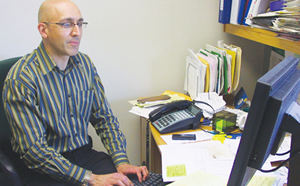
Dr Kishore Visvanathan
blogs about his Advanced Access experiment at www.hqc.sk.ca
|
When family physician Carla Eisenhauer
told her fellow doctors at the Saskatoon Community Clinic
in 2004 they could all but eliminate their wait times,
most of them assumed she'd gone mad. Her patients were
dubious, her receptionist told her it would never work.
"If you tell them that if you measure
supply and demand, your demand is less than your supply,
people say that's crazy," says Dr Eisenhauer.
But Dr Eisenhauer had done her
homework. She convinced her colleagues to try a groundbreaking
scheduling method called Advanced Access developed by
Dr Mark Murray, a researcher with the Institute for
Healthcare Improvement (IHI) in Sacramento which proposes
to slash wait times and make same-day (or very short
notice) booking possible.
"Might as well," one told her,
resigned to the interminably long wait times that plagued
the clinic, "it can't get worse."
He was right: it didn't. It got
better — much better. The average wait time for
an appointment began getting steadily shorter. Even
the reluctant receptionist was convinced. "Within two
weeks," says Dr Eisenhauer, "she walked into my office
and said, 'I love it.'"
Her success has inspired a fellow
Saskatooner, urologist Dr Kishore Visvanathan, to get
his eight-physician practice started on an Advanced
Access experiment, with Dr Eisenhauer on board as an
advisor. Dr Visvanathan is keeping a blog (www.hqc.sk.ca)
where colleagues can follow his clinic's progress.
WAIT
TIME REVOLUTION
The average physician's supply actually outstrips the
demand they face from their patients. Don't believe
it? Just count the number of phone calls you get every
day for a week, suggests Dr Eisenhauer. You may be surprised
to find that you get fewer calls to schedule appointments
than the total number of appointment time-slots you
have. This is the case in up to 80% of physicians' offices,
by some counts.
But, you may be asking, if it's
so easy then why do I constantly feel like I am playing
catch-up? After a crash-course in "queuing theory" Dr
Murray realized something shockingly simple: variation,
not imbalanced supply and demand, creates waiting times.
In other words, your supply might vastly exceed your
demand but if you cannot adjust to the variation in
demand — the busy Monday after March break, the
flu season flurry of activity, etc — then your
wait time will begin to grow. To get rid of your wait
time, you don't need to see patients faster, says Dr
Murray. You just need to see them sooner.
SENSE
OF SATISFACTION
Advanced Access has been used with great success by
a number of facilities around the world, from the UK's
National Health Service and the US Veterans Administration
to current large-scale projects in Alberta, British
Columbia and Saskatchewan and in individual clinics
across Canada.
The results have been promising.
Advanced Access projects have seen patient satisfaction
rise, happier office staff, fewer no-shows and —
most importantly — big cuts in wait times. Dr Eisenhauer's
average wait time has dropped from 17 days to just two
since she began using Advanced Access. "It makes you
as a doctor feel so much better about life," she enthuses.
"I used to go home and feel really tired — zapped.
But these days I come out with a sense of satisfaction."
|
6 ways to see patients faster
So variation is the problem
— but what's the solution? Dr Murray has
identified six principles of the Advanced Access
philosophy that you can use to trim your wait
times:
1 Understand supply and demand.
"In healthcare," explains Dr Murray, "we think
we're in a bad situation, but we are not." Supply
frequently exceeds demand. Taking stock of your
daily demand will prove to you that you do not
need a long wait time, if only you could...
2 Unclog that backlog.
"There's no way to sugar-coat this: it just means
extra work," says Dr Visvanathan. His eight-physician
practice recently managed to see 207 extra people
in just two weeks, hugely reducing its backlog.
Dr Eisenhauer switched from being a half-time
administrator and half-time clinician to a full-time
clinician for a summer to get her practice on
track.
3 Queue variables. A
lot of the variability in physicians' offices
is actually self-imposed, says Dr Murray. Many
doctors schedule different types of visits in
different queues: the wait list for physical exams
might be separate from the wait list for pap smears,
for instance. The unintentional result is that
if, say, a physical exam appointment slot opens
up but the next caller needs a pap smear, the
slot will end up going to waste. Try ignoring
the appointment type when scheduling, except when
a particular room or doctor is required for an
appointment. This is often tougher for specialists
because they tend to change clinical settings
more.
4 Expect the unexpected.
Don't schedule follow-up visits for days in the
future when you know your demand will be higher
than normal, because of seasonal variability or
colleague's vacations or any other factor. Many
doctors find they get more calls on Mondays than
later in the week, so they don't schedule Monday
follow-ups.
5 Reduce demand. For
physicians whose demand turns out to exceed their
supply, it may be necessary to take some additional
measures. Many Advanced Access doctors close their
practices to new patients in order to control
demand.
6 Increase supply. In
order to maximize the amount of supply (time spent
seeing patients), a specialist might ask referring
physicians to perform some of the basic required
tests before making a referral. The same principle
applies for office work: doctors can often delegate
paperwork to another staffer.
|
|